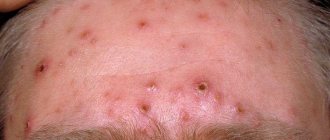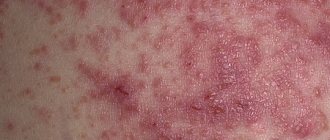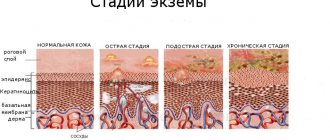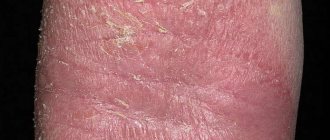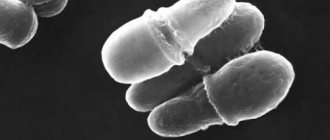Contact dermatitis refers to inflammatory changes that occur in the skin and occur as a response to the direct impact of environmental factors on it. They can appear in any person, regardless of age, on any area of the skin and mucous membranes. Among all contact dermatitis, simple and allergic ones are distinguished. In this article we will consider the first type; allergic dermatitis will be described separately. Simple contact dermatitis is an inflammatory process that occurs as a result of the action of obligate irritating factors on the skin and mucous membranes, causing their damage.
- 2 How do aggressive factors differ in their effects?
- 3 What changes in the skin are caused by aggressive factors?
- 4 Types of dermatitis arising from exposure to mild factors
- 5 How does the effect of strong irritants manifest on the skin?
- 6 What forms of dermatitis occur when exposed to strong irritants?
- 7 What are the features of dermatitis in children?
- 8 How is dermatitis treated?
8.1 What is contact dermatitis (video)
What causes dermatitis on the skin?
All external aggressive factors that cause skin changes are divided into obligate and facultative nature. Obligate are those that can lead to dermatitis in any person. Exposure to facultative factors causes disease only in people who have a predisposition to the action of the substance. Among the obligate aggressive stimuli are:
- Substances of a chemical nature (acid, alkali, solvent, etc.);
- Mechanical origin (exposure to friction and pressure);
- Physical agents (high and low temperature, various radiations);
- Biological factors (plant sap, insect bites - flea dermatitis );
- Exposure to water (long-term), urine, feces, saliva.
Atopic dermatitis
This is a chronic form of allergic dermatitis. The disease may be hereditary. Its cause is a disruption of the immune system.
The treatment is complex and aimed at restoring the body’s immune functions. Drug therapy includes immunomodulators. For the treatment of pathology, the drugs “Timogen”, “Elocom”, “Advantan” were released.
To alleviate the patient’s condition, it is necessary to adhere to the following rules in everyday life:
- The temperature in the room should not exceed 23 0C, and the humidity should be at least 60%.
- To relieve itching, you should take antihistamines.
- Follow a diet, do not use allergens in food.
- Use synthetic fillers in clothes and bedding instead of natural wool and down.
- Remove carpets and books from the patient's room to prevent dust from accumulating.
- Carry out wet cleaning weekly.
- Remove mold and fungi from walls and floors.
- Remove animals and plants.
- Do not use chemical cleaning agents.
- Wear cotton underwear.
- No smoking.
- Avoid physical activity.
- Wash only with natural soap and shampoo.
- Avoid stressful situations.
- Try not to scratch sore areas.
- Patients should abstain from alcohol, sweets, fatty foods and hot spices.
How do aggressive factors differ in their effects?
All agents that cause simple contact dermatitis are divided into 2 categories:
- Pronounced irritants - these include factors that have a strong irritating effect (concentrated acid or alkali, boiling water, ice, electric current, radiation, etc.);
- Weak irritants that have minimal irritating effects: water, soap, urine (most often these are childhood dermatitis ), saliva, feces, a weak solution of acid or alkali, pressure, temperature changes, cold wind, friction, air humidity, etc.
What changes in the skin are caused by aggressive factors?
The strength with which the irritant acts on the skin and how its effect will manifest itself depends on the activity of this factor, on the frequency of exposure and on its nature. If the agent is weak, then the skin protective barrier will be destroyed, microorganisms will penetrate there and a chronic inflammatory process will develop. And when the skin is exposed to strong irritants, cells of the superficial and deep layers of the skin and subcutaneous tissue are destroyed with the formation of necrosis (dead areas).
Seborrheic dermatitis
Once the function of the sebaceous glands is damaged, seborrheic dermatitis can develop. It is expressed by light gray scales and peeling. As a rule, there is an itching sensation.
It can be on the scalp, behind the ears, less often on the body. The cause of the pathology is stress. The pathogenic fungus begins to multiply uncontrollably.
The basis of therapeutic therapy is the tactic of reducing the activity of skin microflora and normalizing metabolism. The main emphasis is on diet, eliminating spicy and fatty foods.
Some doctors supplement treatment with non-hormonal drugs. In each individual case, an individual prescription is issued if there are no contraindications.
Vitamin-mineral complexes are always used as strengthening agents. Hormonal drugs are also prescribed, such as Gistan-N, Fluorocort, and others.
It is necessary to constantly monitor the health of your hair. The appearance of profuse dandruff can be a sign of the proliferation of the Malassezia fungus. It is better to use high-quality shampoos and avoid stress.
Types of dermatitis arising from exposure to mild factors
There are the following forms of this pathology:
- Dermatitis on the skin of the hands, which develops as a result of prolonged exposure of the skin to hot water, soap, juice, brine (laundress hands), as well as exposure to cold, dry air, etc. Manifests itself as redness of the skin, dryness, and the formation of small cracks;
- Abrasions caused by prolonged exposure to friction or pressure. They appear most often in places where belts and shoes rub, and are foci of keratinization - calluses;
- Diaper rash, which develops as a result of skin surfaces rubbing against each other in folds. In infants, they can occur due to poor drying of the skin after a bath.
Types and symptoms of the disease
Contact or allergic dermatitis code according to ICD 10 occurs under the influence of various factors:
- biological (infectious processes in the body);
- physical (mechanical or temperature effects);
- chemical (chemical action of acids and alkaline solutions).
Some types of parasites can also cause dermatitis; in the article about Helmiton they will tell you how to get rid of them.
Depending on the type of allergen, several types of dermatitis can be distinguished:
- Toxicoderma - the allergen enters the body through the digestive or respiratory system, through subcutaneous or intravenous administration. In special cases, the development of Lyell's syndrome is possible, when peeling of the skin occurs. Only resuscitation is possible here, since this is a fairly extensive skin lesion that threatens human life;
- Phytoderma – the allergen is plants, their pollen or juice;
- Contact – manifests itself when the skin comes into direct contact with the allergen.
How does the effect of strong irritants manifest on the skin?
The impact of strong aggressive factors on the skin manifests itself with a clear change of stages in the clinical picture:
- Stage 1 – it is characterized by damage to cells on the surface of the skin, which occurs as a result of a short-term and low-power exposure to an obligate factor. The symptom will be slight redness and swelling of the skin;
- Stage 2 is manifested by irreversible damage to the cells of the entire surface layer of the skin (epidermis). The clinical sign at this stage will be the formation of large blisters containing light-colored contents;
- At stage 3, the cells of two layers of skin (epidermis and dermis) are destroyed with the formation of dead areas (necrosis);
- Stage 4 is characterized by damage to all three layers of the skin (including the hypodermis), as well as tissues that are located deeper.
How to get rid of the disease?
You looked at dozens of photos, carefully studied the symptoms, and after going to the doctor you were finally convinced of the need to treat allergic dermatitis. As a rule, to get rid of the disease the following are prescribed:
- vitamins – they are necessary to maintain immunity;
- probiotics – to normalize intestinal microflora;
- antihistamines - to relieve allergy symptoms;
- corticosteroid ointments and creams - to quickly eliminate the source of inflammation;
- special hygiene products intended for allergy sufferers.
If the dermatitis was caused by a food allergy, then medications will work well in combination with a diet that excludes foods that provoke the release of the hormone histamine into the blood.
What forms of dermatitis occur when exposed to strong irritants?
As a result of the action of aggressive irritants, the following forms of simple contact dermatitis occur:
- A burn caused by exposure of the skin to high temperatures. Burns come in four degrees. The outcome of this form of the disease depends on the area of the affected surface, the degree of damage, the condition of the patient’s body and the likelihood of a secondary bacterial infection;
- Frostbite, which occurs as a result of the action of low temperatures on the skin, leading to cold tissue damage. Most often, exposed skin areas (cheeks, fingers and toes, ears, nose, forehead) are exposed to frostbite. This process is facilitated by high air humidity, the presence of wind, wearing tight shoes, and reduced resistance of the patient’s body, as a result of which frostbite can occur even at a positive ambient temperature (about 7 ° C);
- Solar dermatitis occurs as a result of prolonged exposure to the open sun or when the skin is irradiated with artificial sources of ultraviolet radiation. There are three degrees of severity of the process, which depend on the intensity of the impact and its duration. Sun dermatitis occurs six hours after the action of the causative factor and only on those areas of the skin that were exposed to sunlight. The burn has a clear border and very often runs along the edge of clothing or along the line of sunscreen;
- Radiation dermatitis develops as a result of exposure of the skin to ionizing radiation. The cause is most often radiation therapy for cancer, explosions of atomic weapons, accidents in nuclear reactors, etc. Acute damage is characterized by a change of three stages: first, redness of the skin appears, having a bluish tint, accompanied by hair loss; then bubbles appear; then foci of necrosis. The outcome of acute radiation damage to the skin will be the formation of scars, the development of baldness, a change in skin color with the appearance of its variegation;
- Dermatitis due to electric current. This form of pathology is characterized by the development of areas of necrosis with various changes in the nerves and blood vessels. The appearance of “current signs” on the skin is typical - scabs at the entry and exit points that rise above the surface of the skin. Heal for a long time, with the formation of scars;
- 6. Chemical dermatitis occurs due to the action on the skin of concentrated solutions of acids and alkalis, oxidizing agents, animal poisons, external medications in incorrect concentrations, etc. The development of this process is due to the direct destruction of cells by chemicals.
Allergic dermatitis: 8 photos with descriptions, treatment, causes, symptoms
Allergies have many negative manifestations. A person may cough, sneeze, and their eyes become red and inflamed. Separately, it is necessary to talk about allergic dermatitis - an extremely unpleasant type of skin disease. Even though the disease is treatable and not spreadable to others, it brings a lot of trouble.
Allergic dermatitis in the photo 8 pieces with description
Every year our immunity weakens and becomes vulnerable to many diseases. Previously, skin diseases were considered minor cosmetic defects that no one paid attention to, but today they have become more aggressive, and therefore bring serious health problems to people suffering from them.
Delayed detection or improper treatment of the disease can lead to toxicoderma. This is an acute inflammatory process that can affect the skin and mucous membranes. In order to avoid such a problem, it is recommended to contact specialists in the early stages and begin treatment of the disease.
A person who suspects they have dermatitis should know what it looks like. To do this, you need to carefully study the photo of allergic dermatitis. There are many photographs on the Internet that document various types and stages of allergic dermatitis, which appear in both children and adults. Its foci are located throughout the body.
So, rashes can be on the face, limbs, back. In children, allergic dermatitis looks like urticaria or diathesis, which, in fact, is an allergic reaction of the body to a product. You can verify this by looking at a photo depicting allergic dermatitis.
Allergic dermatitis - causes
What could be the causes of allergic dermatitis? The answer is: as a result of exposure to an irritant on the skin. After close contact with the skin, an allergic reaction is triggered, which has a delayed effect on the body and is manifested by inflammatory processes. The disease occurs when a person comes into contact with an allergen for a long time.
Let's look at common allergens that can trigger the development of allergic dermatitis.
- The cause of the disease can be the plants around us, namely, the substances that they secrete. Pollen, which is a strong allergen, spreads through the air. Some of the plants secrete substances that, when they come into contact with the skin, make it more sensitive to solar radiation. Research confirms that even the sap from plants we grow in our homes can cause skin problems. As for citrus fruits: lemons, oranges and tangerines, they are considered the strongest of all existing allergens! Even the smoke from dry burnt plants is hazardous to the health of some people.
- Allergic dermatitis can appear from cosmetic products.
- Instruments used in dentistry and dental and mouth care products can cause severe allergies and, as a result, dermatitis.
- Medicines and vitamins in large doses can cause an allergic reaction.
The cause of allergic dermatitis can be the field of activity in which a person works. Representatives of certain professions regularly and for a long time deal with substances that can act as irritants and provoke this type of dermatitis. People working in medicine, cosmetology, construction, food and industrial sectors are at risk.
Dermatitis caused by allergies is diagnosed in children, especially infants. A baby’s immune system has to face many difficulties, so he is susceptible to the disease more often than an adult.
Nothing good should be expected if a nursing mother does not follow a diet while breastfeeding - she eats a lot of sweets, citrus fruits, red apples and other foods that are strictly prohibited in such cases. In a child who has been introduced to complementary foods, allergic dermatitis may be caused by a certain product.
It happens that after eating eggs, cereals, fruits, berries, fish and dairy products or soy, rashes appear. Such products are introduced into the child’s diet very carefully and under the strict supervision of a specialist.
The disease can be inherited. Most often, children suffer from this. If a mother monitors her health (especially during pregnancy and breastfeeding) and does not excessively consume foods that cause allergic reactions, then the problem can be avoided or its consequences for the child can be reduced.
If your house is dusty and dirty, and you also have a pet, then don’t be surprised where the allergies come from. Before the birth of a child, permanently get rid of factors that may negatively affect his health in the future.
Find out more
Symptoms of allergic dermatitis
Externally, allergic dermatitis is similar to eczema. At the initial stage of the disease, the appearance of large red spots can be observed. The spots turn into many small bubbles. They burst, leaving scales, crusts or other defects on the skin, similar to spots.
The main focus is in the place where the allergen came into contact with the skin. Other lesions may be scattered throughout the human body. This is explained by the fact that allergies and their consequences are not a local problem.
The disease negatively affects the entire body, so it is necessary to combat it using comprehensive methods. Treating only those areas where the rash appears is unsuccessful. This treatment may bring temporary relief and disappearance of symptoms. The main problem will remain.
Red spots turning into blisters and other manifestations of the disease may appear at a great distance from the area in contact with the allergen. For example, if the disease was caused by an allergic reaction to mascara previously applied to the eyelashes, then the skin lesions can affect not only the eye or face area, but also the neck, and even spread to the human body.
A patient diagnosed with allergic dermatitis complains of severe itching and discomfort, which not only disrupts his daily life, but also prevents him from getting a good night's sleep. The development of the disease is indicated by a rash, as well as redness of some areas of the skin. A person should be alert to peeling skin, which is a symptom of the chronic course of the disease.
Treatment of allergic dermatitis
As already mentioned, untimely or improper treatment of allergic dermatitis aggravates the disease and causes serious complications.
The first thing dermatologists recommend after identifying a disease in a patient is to eliminate the allergen that caused it.
Most often, the irritant is substances contained in cosmetics, perfumes, powders, various cleaning and detergents.
They must be immediately excluded from your life or replaced with hypoallergenic products. This also applies to foods that cause an allergic reaction. If your body does not accept certain foods, eliminate them from your diet. If the development of the disease is associated with a profession that you have been engaged in for many years, then you should think about changing your job.
Otherwise, you can develop chronic eczema, which will be difficult to cure. However, you should not make a diagnosis yourself. You should consult a dermatologist, and if necessary, take allergy tests to identify the cause of the disease.
It often happens that by stopping contact with the causative agent of a disease, a person gets rid of it forever. But if the stage of the disease is more advanced, then drastic measures must be taken.
The first thing that is prescribed to alleviate the patient’s condition is various creams and ointments that relieve itching, redness and flaking. Treatment cannot be carried out without the use of antiallergic drugs.
At an advanced stage, laser therapy is prescribed. The laser cleanses the skin of external signs of disease and improves the functioning of the immune system. Allergic dermatitis is not only a skin disease. Its appearance warns a person about serious problems and malfunctions in the functioning of the entire body.
For dermatitis, including allergic ones, it is important to follow a diet. It should be prescribed by a doctor after conducting the necessary studies. Refusal to eat foods that provoke an allergic reaction is mandatory.
A specialist will provide a list of these products. If you wish, you can view them on the Internet. You should limit salt and sugar in your diet.
The way food is prepared is no less important than the food itself. If a person previously ate fried, smoked or baked foods without restriction, this could cause the development of the disease.
For dietary purposes, boiled or steamed food is recommended.
Allergic dermatitis - prevention
It is better not to treat allergic dermatitis, but to prevent it. Today there are many reasons for this phenomenon:
- excessive hygiene, which uses various chemicals that are dangerous to humans;
- food laced with chemicals;
- unfavorable environment;
- genetic predisposition;
- constant nervous tension;
- bad habits.
Therefore, this disease, like any other, is easier to prevent than to seek treatment. If we are talking about an infant, then prevention must be carried out before birth. A pregnant woman should completely avoid foods and medications that can trigger allergies.
After the birth of the child, the mother must follow a strict diet and carefully care for the delicate skin of the newborn. Properly introduced complementary foods, agreed upon with the pediatrician, are important.
Prevention of the disease for an adult consists of preliminary diagnosis, taking samples and tests. It is necessary to take all possible measures and eliminate allergy-provoking factors.
If a person has dry skin, it requires special care. This problem can lead to inflammation. Increased moisture in the skin is, like excessive dryness, a sign of a malfunction of the body. Using untested moisturizers and frequent body washing may increase the reaction to a certain allergen.
Knowing that some foods can trigger allergies, you should absolutely not consume them. It is better to eliminate them from your diet forever.
But the main factors that provoke skin diseases, including those of an allergic nature, are the stress that accompanies us every day, as well as bad habits that further weaken the body. Practice shows that most diseases are the result of dysfunction of the nervous system. Be calm and lead a healthy lifestyle!
Source: //www.dermatit.net/dermatit/allergicheskij-dermatit/
What are the features of dermatitis in children?
In children, the following forms most often occur, caused by the action of weak stimuli:
- Diaper dermatitis (or ammonia). It is diaper rash in the perineum and anus, which occurs as a result of constant excess moisture and irritation of the skin with urine and feces. The skin in these areas is reddened, shiny, and erosions may appear. A variant of this form is perianal dermatitis , which occurs in the crease between the buttocks;
- Dermatitis that develops as a result of a child's thumb sucking. Most often, this form occurs in young children under two years of age. As a rule, the lesion affects the finger of one hand (thumb);
- Burn. Infants and young children most often experience solar dermatitis due to age-related immaturity of the protective properties of the skin. Also, in children of this age, skin damage can occur when swimming in water with a temperature of more than 40 ° C. In children under 3 years of age, thermal burns are often possible due to scalding by hot liquids;
- Irritative dermatitis, which occurs in those children who spend a lot of time in water and also do not wear gloves in winter;
- Chilling is a special type of cold skin damage and develops as a result of low temperature, high humidity and wind. All this occurs against the background of increased sensitivity of children's skin to these irritants due to imperfect regulation of vascular tone. Clinically, chills are manifested by the paroxysmal appearance on the skin of the cheeks, ears and fingers of spots with clear boundaries, rising above the surface, which itch and itch;
Simple cheilitis, which occurs as a result of the child constantly licking his lips. It occurs most often in winter in young children and adolescents. Clinically, this type of dermatitis is manifested by dry skin of the lips, the appearance of cracks and small scales on them, and severe itching.
On eyelids and eyes
When dermatitis is localized on the eyelids, the patient experiences redness and swelling of the tissues, irritation, pain, itching and rash. Upon examination, you can detect roughening of the skin, it is hot to the touch, peeling appears due to dry skin, and sometimes the skin, on the contrary, becomes weeping.
If not treated in a timely manner, allergies may be accompanied by a secondary infection - conjunctivitis, accompanied by pain in the eyes and discharge in the form of a sticky liquid. The patient may also suffer from headaches, chills, weakness and loss of appetite. This condition most often develops with the use of medications and low-quality cosmetics.
When allergic dermatitis appears in the eyes, redness of the eyelids occurs, often accompanied by conjunctivitis. The reaction often occurs while taking medications or using cosmetics.
The main symptoms of eye allergies include:
- rash;
- skin redness;
- burning and itching;
- pain and feeling of sand in the eyes;
- tearfulness;
- swelling.
The chronic form of such dermatitis most often manifests itself in the gradual development of symptoms. First, the skin of the eyelids thickens, after which it changes its color to red-pink, the skin becomes dry and wrinkled, and rashes appear. Before all symptoms appear, the patient may complain of pain in the eyes, soreness, burning and itching. The damage to the eyelids occurs symmetrically to each other.
Treatment of allergic dermatitis of the eyelids
Initially, it is necessary to exclude contact of the allergen with the skin. For local therapy, ointments (Celestoderm B) are prescribed, which must be used three times a day, applied to the surface of the eyelids. The course of treatment is 1-2 weeks, depending on the course of the allergy. General medications such as calcium chloride or antihistamines, as well as eye drops that prevent the development of conjunctivitis, can help reduce symptoms.
How is dermatitis treated?
The main thing in the treatment of this pathology is the elimination of the causative factor. Next, treatment is carried out, which depends on the clinical manifestations:
- For redness of the skin - creams with hormones;
- If there is a wet surface - aerosols, lotions, wet dressings containing hormonal drugs;
- In case of a chemical burn, rinse the damaged area with copious amounts of water;
- If there are blisters, puncture them with a sterile needle to cause them to subside;
- If there are ulcers and necrosis of skin areas, they are excised and then treated with preparations containing enzymes, antibiotics and stimulants of tissue regeneration processes.
If the dermatitis is extensive (large area burns), then the patient requires anti-shock therapy using hormonal medications, painkillers, sedatives, antiallergic, antibacterial and copious amounts of intravenous fluid.
What is contact dermatitis (video)
- Author: Olga
Rate this article:
- 5
- 4
- 3
- 2
- 1
(0 votes, average: 0 out of 5)
Share with your friends!
Endometriosis: concept, causes and clinical varieties
Sarcoidosis: clinical manifestations, treatment recommendations
Treatment of the disease
How to treat allergic dermatitis? First of all visit:
- dermatologist;
- allergist.
Specialists will conduct skin tests to identify the irritant or group of provoking factors. “Allergotest” is effective - a set of plates containing 24 allergens.
Needed:
- blood analysis;
- detailed report of exposure to allergens;
- information about the nature of the disease.
Complex therapy is aimed at relieving inflammation and desensitizing the body. Sensitivity can be reduced by using medications. Not only special ointments and creams, but also folk remedies have an anti-inflammatory effect.
We offer you to read an interesting article about how to treat diathesis on the cheeks of a child.
How to cure lip stains? This article has the answer!
After clicking on the link, you can find interesting information about erythema nodosum.


